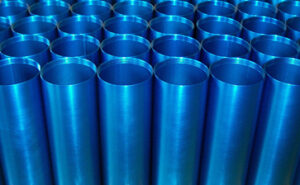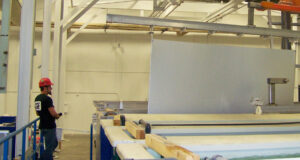The following article from AAC member Anne Deacon Juhl, AluConsult is excerpted from Light Metal Age (www.lightmetalage.com)
The aluminum extrusion and sheet industries are playing an important role in reducing the negative impacts of industrial activities on the environment. This is for a variety of reasons, but is mainly due to the fact that, since aluminum’s fundamental properties do not change with repetitive melting, the material can be recycled infinitely without degradation of those properties.
To make the aluminum industry even more sustainable, OEMs, designers, and engineers need to understand the ways in which they can make more environmentally friendly choices in regards to primary reduction and recycling. In primary reduction, this refers to reducing the CO2 footprint of aluminum in various steps of the production process. On the other hand, recycling refers to ensuring the recyclability of aluminum and to choosing recycled aluminum.
Recycling Aluminum
Aluminum is the second most used metal in the world after steel with a global market of around 64 million tons and with a recycled aluminum production of around 12 million tons in 2018. For many years, aluminum recycling was all about used beverage cans (UBCs). Now all types of scrap materials need to be and are recycled, including both production and post-consumer scrap.
Production scrap, also called process scrap, refers to aluminum waste that comes directly from the production of cast, semi-finished, or finished products. These scrap materials are easy to recycle, because the aluminum has neither been painted or coated nor joined or assembled with other materials. In other words, it is still the original aluminum alloy.
Post-consumer scrap refers to aluminum products that have been used and are ready for disposal, recycling, or reuse. The amount of post-consumer scrap is lower than production scrap, as it presents two main difficulties. First, the recycling of post-consumer scrap is a complex process with many steps, including collection, inspection, separation, shredding, and decoating prior to remelting (Figure 1). Second, the aluminum scrap also needs to be analyzed (using x-ray or other methods) to determine the alloy elements and separate them, as different types of alloys should not be remelted together in order to avoid a loss of quality. However, the sorting process is still not ideal and needs to be further refined.
Sustainable Anodizing Anodizing is an electro-chemical process that creates an aluminum oxide layer. The anodic coating is generated from the base metal in a water-based process using an electrical current. This means the anodized layer consists of ultra-thin, nontoxic aluminum oxide that naturally forms when aluminum gets in contact with air. Thus, anodizing does not only make the aluminum more durable, but also ensures its recyclability, as no extra material is added to the surface.
Anodizing is an electro-chemical process that creates an aluminum oxide layer. The anodic coating is generated from the base metal in a water-based process using an electrical current. This means the anodized layer consists of ultra-thin, nontoxic aluminum oxide that naturally forms when aluminum gets in contact with air. Thus, anodizing does not only make the aluminum more durable, but also ensures its recyclability, as no extra material is added to the surface.
While anodizing is a green surface treatment by nature, certain aspects can make the anodizing process more or less environmentally friendly. As OEMs and product manufacturers consider the whole supply chain in their sustainability measures, the following requirements should be specified when working with an anodizer or choosing an anodizing supplier.
Specifying Alloys
Alloy selection is a key aspect of ensuring a proper anodized coating. Alloys made from primary aluminum (regardless of their carbon footprint) generally have low impurities. However, alloys made from recycled post-consumer scrap are at greater risk of containing iron, copper, and zinc impurities. Increased amounts of iron will lead to darkening of the anodic coating and a decrease in corrosion resistance in connection with other alloying elements. An increase in zinc can result in spangling of the surface during the etching process. A higher content of copper and zinc can lead to inter-granular corrosion (IGC). Therefore, recycled aluminum alloys must be carefully inspected to ensure that they contain low impurity levels.
Pre-Treatment
As noted in a previous article,3 the pretreatment steps include degreasing, etching, and desmutting. These steps include chemicals (such as sodium hydroxide or acids), water, and heating as their main consumables, with no toxic chemicals. Thus, the pretreatment stage is naturally environmentally friendly.
Anodizing The anodizing process step is driven by an electrical current, and the amount of electric charge (coulomb) that passes through the aluminum will decide the thickness of the formed anodic layer. Therefore, a current-controlled method will make the anodizing process more efficient compared to using voltage control. Moreover, using pulse anodizing decreases the process time by half, making the process even more efficient.4 Thus, to ensure an energy-efficient process, anodizers should agree to perform current-controlled anodizing and, if the equipment is available, also use pulse anodizing.
The anodizing process step is driven by an electrical current, and the amount of electric charge (coulomb) that passes through the aluminum will decide the thickness of the formed anodic layer. Therefore, a current-controlled method will make the anodizing process more efficient compared to using voltage control. Moreover, using pulse anodizing decreases the process time by half, making the process even more efficient.4 Thus, to ensure an energy-efficient process, anodizers should agree to perform current-controlled anodizing and, if the equipment is available, also use pulse anodizing.
Waste Treatment
The sulfuric acid anodizing process produces two main byproducts that need handling—aluminum hydroxide and degraded sulfuric acid. The U.S. EPA classifies aluminum hydroxide as hazardous, meaning the wastewater from an anodizing line cannot be drained into the municipal wastewater system. When working with anodizing suppliers outside of Europe and the U.S., it is especially important to verify that the anodizer is responsibly handling the wastewater, as regulations in other countries are less strict.
Read the full article HERE.


